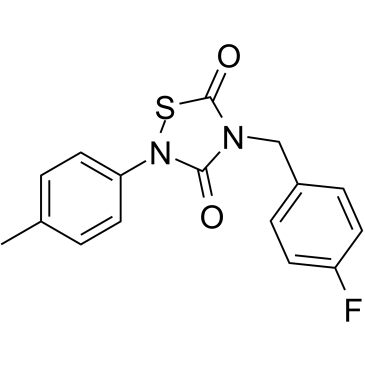| Cas No.: | 883050-24-6 |
| Chemical Name: | 4-[(4-Fluorophenyl)methyl]-2-(4-methylphenyl)-1,2,4-thiadiazolidine-3,5-dione |
| Synonyms: | CCG50014;CCG 50014 |
| SMILES: | FC1C=CC(CN2C(=O)SN(C3C=CC(C)=CC=3)C2=O)=CC=1 |
| Formula: | C16H13FN2O2S |
| M.Wt: | 316.35 |
| Purity: | >98% |
| Sotrage: | 2 years -20°C Powder, 2 weeks 4°C in DMSO, 6 months -80°C in DMSO |
| Description: | CCG-50014 is the most potent against the regulator of G-protein signaling protein type 4 (RGS4) (IC50 =30 nM) and is >20-fold selective for RGS4 over other RGS proteins. CCG-50014 binds covalently to the RGS, forming an adduct on two cysteine residues located in an allosteric regulatory site[1]. CCG50014, reduces nociceptive responses and enhances opioid-mediated analgesic effects in the mouse formalin test[2]. |
| Target: | RGS4:30 nM (IC50) RGS8:11 μM (IC50) RGS16:3.5 μM (IC50) RGS19:0.12 μM (IC50) |
| In Vivo: | CCG50014 (10, 30, or 100 nM) attenuates the nociceptive responses during the late phase in a dose-dependent manner[2]. |
| References: | [1]. Blazer LL, et al. A nanomolar-potency small molecule inhibitor of regulator of G-protein signaling proteins. Biochemistry. 2011 Apr 19;50(15):3181-92. [2]. Yoon SY, et al. Intrathecal RGS4 inhibitor, CCG50014, reduces nociceptive responses and enhances opioid-mediated analgesic effects in the mouse formalin test. Anesth Analg. 2015 Mar;120(3):671-7. |

 DC Chemicals' products qualify for U.S. tariff exemptions. We guarantee no price increases due to customs duties and maintain stable supply, continuing to deliver reliable research solutions to our American clients.
DC Chemicals' products qualify for U.S. tariff exemptions. We guarantee no price increases due to customs duties and maintain stable supply, continuing to deliver reliable research solutions to our American clients.





















